
New Kingdom Treasures
![]()
Extreme prosperity and renaissance in art and building projects mark the beginning of the New Kingdom period. Towards the end of the 19th Dynasty the increasing power of the priesthood corrupts the central government. During the 20th Dynasty tomb robbing is done by officials. The priesthood becomes hereditary and begins to assume secular power. The government breaks down. |
![]()
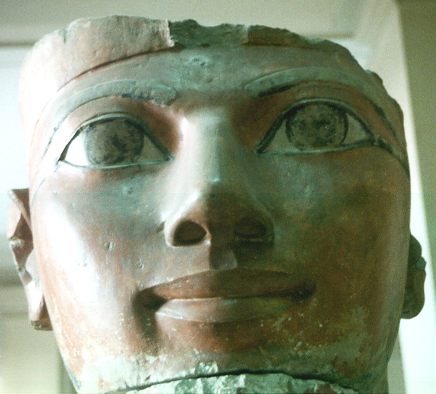 This head of a colossal
statue of Hatshepsut would once have
crowned one of the Osirian pillars that decorated the portico of the third terrace of her
temple at Deir el-Bahri. Some of the characteristic stylistic features of the
statuary of Hatshepsut are present in this head. The face is triangular and the
features are very delicate. The striking almond-shaped eyes, decorated with a line
of kohl extending to the temples, have large dilated pupils, imparting a sense of
innocence and purity. The slightly arched nose is long and slim. The small
mouth is set in a faint smile. The same face is found not only on many other statues
of Hatshepsut, but also on those representing private individuals of the same period.
One unusual element is the dark red color of the skin, usually a feature of male
images. It is justified in this case by the fact that Hatshepsut is represented here
as a pharaoh in Osirian form. From what remains of Hatshepsut's headdress, it can be
deduced that she wore the double crown symbolizing the union between Upper and Lower
Egypt. 18th Dynasty
This head of a colossal
statue of Hatshepsut would once have
crowned one of the Osirian pillars that decorated the portico of the third terrace of her
temple at Deir el-Bahri. Some of the characteristic stylistic features of the
statuary of Hatshepsut are present in this head. The face is triangular and the
features are very delicate. The striking almond-shaped eyes, decorated with a line
of kohl extending to the temples, have large dilated pupils, imparting a sense of
innocence and purity. The slightly arched nose is long and slim. The small
mouth is set in a faint smile. The same face is found not only on many other statues
of Hatshepsut, but also on those representing private individuals of the same period.
One unusual element is the dark red color of the skin, usually a feature of male
images. It is justified in this case by the fact that Hatshepsut is represented here
as a pharaoh in Osirian form. From what remains of Hatshepsut's headdress, it can be
deduced that she wore the double crown symbolizing the union between Upper and Lower
Egypt. 18th Dynasty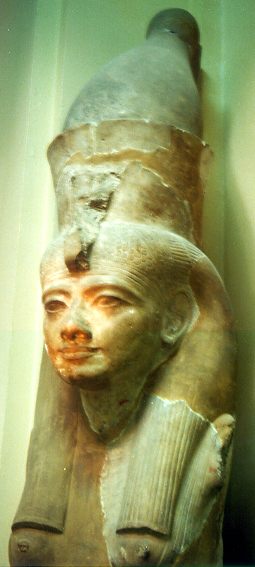 Hatshepsut (1473-1458 B.C.) was the daughter
of Tuthmosis I, and carried the blood of
Ahmose who, two generations earlier had finally freed Egypt from Hyksos rule. She married her father's son
and heir, Tuthmosis II, who died before she could bear him an heir. A secondary wife
gave birth to the heir apparent, Tuthmosis III. At the death of the pharaoh,
however, Hatshepsut did not step down, but reigned as the pharaoh's widow. After a
number of years she then took the unprecedented step of declaring herself pharaoh.
In principle it was a co-regency, but it appears that for about 20 years Hatshepsut
wielded power alone while Tuthmosis acquired his reputation as the Napoleon of Egypt,
expanding and solidifying the Egyptian empire. Twice before in Egypt, queens had
reigned for brief periods, but never had they taken the title of pharaoh. In keeping
with the unalterable masculinity of kingship, Hatshepsut in many instances had herself
portrayed as a man, wearing the royal false beard; in other reliefs and sculptures (such
as is the case with this one) she is shown as a woman. Here she wears the double
crown of Upper and Lower Egypt adorned with a Uraeus.
18th Dynasty
Hatshepsut (1473-1458 B.C.) was the daughter
of Tuthmosis I, and carried the blood of
Ahmose who, two generations earlier had finally freed Egypt from Hyksos rule. She married her father's son
and heir, Tuthmosis II, who died before she could bear him an heir. A secondary wife
gave birth to the heir apparent, Tuthmosis III. At the death of the pharaoh,
however, Hatshepsut did not step down, but reigned as the pharaoh's widow. After a
number of years she then took the unprecedented step of declaring herself pharaoh.
In principle it was a co-regency, but it appears that for about 20 years Hatshepsut
wielded power alone while Tuthmosis acquired his reputation as the Napoleon of Egypt,
expanding and solidifying the Egyptian empire. Twice before in Egypt, queens had
reigned for brief periods, but never had they taken the title of pharaoh. In keeping
with the unalterable masculinity of kingship, Hatshepsut in many instances had herself
portrayed as a man, wearing the royal false beard; in other reliefs and sculptures (such
as is the case with this one) she is shown as a woman. Here she wears the double
crown of Upper and Lower Egypt adorned with a Uraeus.
18th Dynasty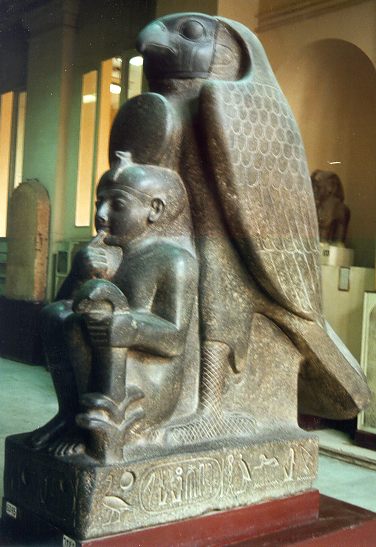 This colossal granite statue was
found in the ruins of a mud-brick building at Tanis. The falcon's beak, carved from
a separate piece of limestone, was discovered in an adjacent room. The statue
represents Ramesses II with the features of
a young boy. He is naked and seated. He holds one finger of his right hand up
to his mouth and a large side lock of hair descends to the shoulder. Both of these
features are characteristic of representations of adolescents in ancient Egypt. The
pharaoh wears a cap decorated on the forehead with a cobra, the symbol of kingship.
On his head is a solar disc and in his left hand he holds a reed. This last detail
is not found in the typical images of the pharaoh. It indicates that, as in many of
other representations of Ramesses II, the image is to be read as a graphic puzzle in the
form of a rebus. In hieroglyphic writing, the solar disc on the head signifies re,
the child mes and the plant su. Reading the three symbols from top
to bottom yields the word Ramessu, the name of the pharaoh. Behind Ramesses
II looms the figure of the god Horun in the form of a falcon. As in earlier statues,
the falcon is symbolically protecting the pharaoh. The bird is shown in a highly
stylized manner, with details of plumage and the talons shown by incised lines that
produce a geometric decorative effect, rather than a faithful representation of
reality. 19th Dynasty
This colossal granite statue was
found in the ruins of a mud-brick building at Tanis. The falcon's beak, carved from
a separate piece of limestone, was discovered in an adjacent room. The statue
represents Ramesses II with the features of
a young boy. He is naked and seated. He holds one finger of his right hand up
to his mouth and a large side lock of hair descends to the shoulder. Both of these
features are characteristic of representations of adolescents in ancient Egypt. The
pharaoh wears a cap decorated on the forehead with a cobra, the symbol of kingship.
On his head is a solar disc and in his left hand he holds a reed. This last detail
is not found in the typical images of the pharaoh. It indicates that, as in many of
other representations of Ramesses II, the image is to be read as a graphic puzzle in the
form of a rebus. In hieroglyphic writing, the solar disc on the head signifies re,
the child mes and the plant su. Reading the three symbols from top
to bottom yields the word Ramessu, the name of the pharaoh. Behind Ramesses
II looms the figure of the god Horun in the form of a falcon. As in earlier statues,
the falcon is symbolically protecting the pharaoh. The bird is shown in a highly
stylized manner, with details of plumage and the talons shown by incised lines that
produce a geometric decorative effect, rather than a faithful representation of
reality. 19th Dynasty Even though only the titles and not the name of the queen are preserved on
the rear pilaster, this piece has been identified as a statue of Meritamun, also known as the White Queen,
a daughter of Ramesses II. On the death of Nefertari (some time after the
twenty-first year of the pharaoh's reign) she took on the role of the Great Royal Wife.
This identification was made possible by the discovery at Akhmim in recent years of
an identical colossal statue of Meritamun found in the ruins of the Ramesseum. The
painted decoration of the statue is still well preserved. The yellow of some of the
facial features and decorative elements combines well with the blue of the wig, both of
which are enhanced by the extremely fine limestone used for the sculpture. On the
top of her head, the queen wears a circular diadem, its base decorated all the way round
with a frieze of uraei with solar disks. From this base would have once
risen a double plum with a solar disc at the center, a prerogative of the Great Royal
Brides. 19th Dynasty
Even though only the titles and not the name of the queen are preserved on
the rear pilaster, this piece has been identified as a statue of Meritamun, also known as the White Queen,
a daughter of Ramesses II. On the death of Nefertari (some time after the
twenty-first year of the pharaoh's reign) she took on the role of the Great Royal Wife.
This identification was made possible by the discovery at Akhmim in recent years of
an identical colossal statue of Meritamun found in the ruins of the Ramesseum. The
painted decoration of the statue is still well preserved. The yellow of some of the
facial features and decorative elements combines well with the blue of the wig, both of
which are enhanced by the extremely fine limestone used for the sculpture. On the
top of her head, the queen wears a circular diadem, its base decorated all the way round
with a frieze of uraei with solar disks. From this base would have once
risen a double plum with a solar disc at the center, a prerogative of the Great Royal
Brides. 19th Dynasty
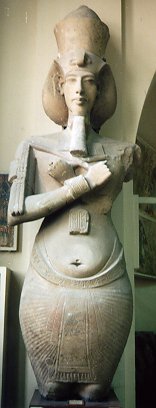 Prior to founding his new capital at Tell el-Amarna, Amenhotep IV, who
changed his name to Akhenaten between the
fifth and sixth year of his reign, inaugurated a vast building program at Thebes, close to
the temple of Karnak. The young pharaoh's intention was to
provide an alternative to the cult of Amun by the construction of four sacred buildings
dedicated to Aten in the proximity of the stronghold of the Theban clergy who openly
opposed the religious reforms. To the east of the temple of Karnak, rose the Gempaaten,
which translates as 'The solar disc has been found'. This was the first shrine
constructed by Amenhotep IV and consisted of a large porticoed courtyard oriented on an
east-west axis. Placed against each of the pillars in the courtyard was a colossal
statue of Amenhotep IV, over five meters high and painted in bright colors. Pictured
here is one of the several colossal sandstone statues of Akhenaten found in the peristyle
court. His arms are folded and his hands hold the insignia of pharaonic power, the heqa
scepter and the flail. Around his wrists and on his arms, as if they were incised on
bracelets, are cartouches with the complicated name given to the deified solar disc,
'Re-Horakhty who rejoices to the horizon in his name that is "Shu [or "The
Light] that resides in the solar disc."' Akhenaten's curious physiognomy has
been the source of much speculation. The statue has a height of 3.96 meters. 18th
Dynasty, c. 1350 BCE.
Prior to founding his new capital at Tell el-Amarna, Amenhotep IV, who
changed his name to Akhenaten between the
fifth and sixth year of his reign, inaugurated a vast building program at Thebes, close to
the temple of Karnak. The young pharaoh's intention was to
provide an alternative to the cult of Amun by the construction of four sacred buildings
dedicated to Aten in the proximity of the stronghold of the Theban clergy who openly
opposed the religious reforms. To the east of the temple of Karnak, rose the Gempaaten,
which translates as 'The solar disc has been found'. This was the first shrine
constructed by Amenhotep IV and consisted of a large porticoed courtyard oriented on an
east-west axis. Placed against each of the pillars in the courtyard was a colossal
statue of Amenhotep IV, over five meters high and painted in bright colors. Pictured
here is one of the several colossal sandstone statues of Akhenaten found in the peristyle
court. His arms are folded and his hands hold the insignia of pharaonic power, the heqa
scepter and the flail. Around his wrists and on his arms, as if they were incised on
bracelets, are cartouches with the complicated name given to the deified solar disc,
'Re-Horakhty who rejoices to the horizon in his name that is "Shu [or "The
Light] that resides in the solar disc."' Akhenaten's curious physiognomy has
been the source of much speculation. The statue has a height of 3.96 meters. 18th
Dynasty, c. 1350 BCE.
 This exquisite small painted limestone statuette
of Akhenaten comes from the luxurious home of one of the nobles who adopted the religious
reforms of Akhenaten and decided to follow the pharaoh to the city of Akhenaten, the
capital founded in Middle Egypt. The small statue would have been located on the
alter that was usually found in gardens and where the daily rituals in honor of the Aten
were performed. The Aten was the the deified solar disc at the center of the
religious upheaval in Egypt during this period. The presence of an effigy of the
pharaoh guaranteed the validity of the ceremony, given that only Akhenaten had the
prerogative of making offerings to the god. Akhenaten is shown in the act of making
an offering. His hands are holding a slab on which a number of foods and lotus
flowers are depicted. Although this type of statuary is known from as early as the
Middle Kingdom, the pose in which Akhenaten stands portrayed
is very unusual. The fact that his legs are together contrasts with the most
elementary rules of Egyptian sculpture, which always features male figures in striding
poses with the left leg advanced. And in the art of the Amarna period where light
and movement played essential roles in figurative depictions, the immobility of the
composition is all the more surprising and suggests that it was the result of a deliberate
decision. On his head, the pharaoh wears the Blue Crown (carved separately) which by
Amenhotep III's reign had evolved from a headdress used mainly in military images to
become part of the classic iconography associated with the monarch. Akhenaten's body
is also reproduced with the fullness of form typical of the portraits of this ruler,
although perhaps not to the same degree as in other portraits. The solemnity of the
moment is underlined by the fact that the pharaoh is wearing sandals on his feet.
The Egyptians only wore this kind of footwear on special occasions or for religious
ceremonies. 18th Dynasty
This exquisite small painted limestone statuette
of Akhenaten comes from the luxurious home of one of the nobles who adopted the religious
reforms of Akhenaten and decided to follow the pharaoh to the city of Akhenaten, the
capital founded in Middle Egypt. The small statue would have been located on the
alter that was usually found in gardens and where the daily rituals in honor of the Aten
were performed. The Aten was the the deified solar disc at the center of the
religious upheaval in Egypt during this period. The presence of an effigy of the
pharaoh guaranteed the validity of the ceremony, given that only Akhenaten had the
prerogative of making offerings to the god. Akhenaten is shown in the act of making
an offering. His hands are holding a slab on which a number of foods and lotus
flowers are depicted. Although this type of statuary is known from as early as the
Middle Kingdom, the pose in which Akhenaten stands portrayed
is very unusual. The fact that his legs are together contrasts with the most
elementary rules of Egyptian sculpture, which always features male figures in striding
poses with the left leg advanced. And in the art of the Amarna period where light
and movement played essential roles in figurative depictions, the immobility of the
composition is all the more surprising and suggests that it was the result of a deliberate
decision. On his head, the pharaoh wears the Blue Crown (carved separately) which by
Amenhotep III's reign had evolved from a headdress used mainly in military images to
become part of the classic iconography associated with the monarch. Akhenaten's body
is also reproduced with the fullness of form typical of the portraits of this ruler,
although perhaps not to the same degree as in other portraits. The solemnity of the
moment is underlined by the fact that the pharaoh is wearing sandals on his feet.
The Egyptians only wore this kind of footwear on special occasions or for religious
ceremonies. 18th Dynasty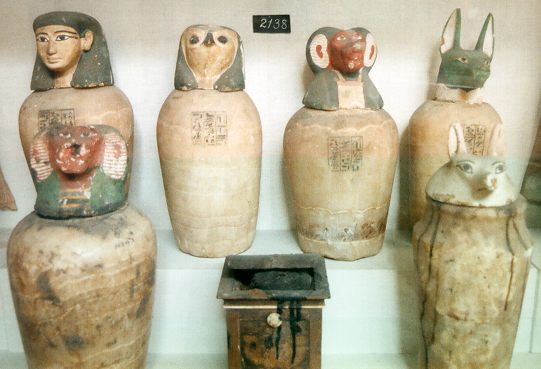 Various Canopic Jars used for the
burial of the viscera removed during mummification.
The specific organs stored in the jars were the liver, lungs, stomach and intestines. In
the late 18th-Dynasty the stoppers were
human headed, as is the case for Tutankhamun's, but from the
latter 18th Dynasty onwards it became more common for the stoppers to take the form of the
characteristic heads of the four sons of Horus who were responsible for the protection of
the organs. By the 19th-Dynasty these had
completely replaced the human-headed type.
Various Canopic Jars used for the
burial of the viscera removed during mummification.
The specific organs stored in the jars were the liver, lungs, stomach and intestines. In
the late 18th-Dynasty the stoppers were
human headed, as is the case for Tutankhamun's, but from the
latter 18th Dynasty onwards it became more common for the stoppers to take the form of the
characteristic heads of the four sons of Horus who were responsible for the protection of
the organs. By the 19th-Dynasty these had
completely replaced the human-headed type. These four vases were discovered in the
northeast corner of the burial chamber at the foot of the great sarcophagus of Yuya.
They were all found attached to a single base of painted wood and their interiors
are hollow only to a depth of four centimeters. Three have twin loop handles while
the fourth has a false spout in the form of an ibex head. The lids are carved in the
shape of animals. The first on the left reproduces the head of a calf with black
markings, the second repeats the ibex motif found on the spout but this time the animal is
shown reclining, the third has a frog and the fourth again features the head of a calf,
this time with read markings. Each vase has inscriptions addressed to Yuya painted
on the body in two columns of cursive hieroglyphs. These four vases, like many in
the tomb of Yuya and Tuyu, were imitations of vessels made from more precious materials.
That they were not actually intended to be used is demonstrated by the internal
cavities which are too shallow to be able to contain anything. Their white coloring
is undoubtedly a reference to alabaster. Yuya's vases should therefore be seen as
imitations of vessels that contained unguents and perfumed oils. The fact that they
were false did not prevent them from being considered as effective equivalents of the
models that inspired them. Their presence was sufficient to ensure that the contents
of the vessels reproduced were symbolically part of the funerary equipment. 18th
Dynasty
These four vases were discovered in the
northeast corner of the burial chamber at the foot of the great sarcophagus of Yuya.
They were all found attached to a single base of painted wood and their interiors
are hollow only to a depth of four centimeters. Three have twin loop handles while
the fourth has a false spout in the form of an ibex head. The lids are carved in the
shape of animals. The first on the left reproduces the head of a calf with black
markings, the second repeats the ibex motif found on the spout but this time the animal is
shown reclining, the third has a frog and the fourth again features the head of a calf,
this time with read markings. Each vase has inscriptions addressed to Yuya painted
on the body in two columns of cursive hieroglyphs. These four vases, like many in
the tomb of Yuya and Tuyu, were imitations of vessels made from more precious materials.
That they were not actually intended to be used is demonstrated by the internal
cavities which are too shallow to be able to contain anything. Their white coloring
is undoubtedly a reference to alabaster. Yuya's vases should therefore be seen as
imitations of vessels that contained unguents and perfumed oils. The fact that they
were false did not prevent them from being considered as effective equivalents of the
models that inspired them. Their presence was sufficient to ensure that the contents
of the vessels reproduced were symbolically part of the funerary equipment. 18th
Dynasty© All pictures are Copyright 1998 - 2001 Grisel Gonzalez